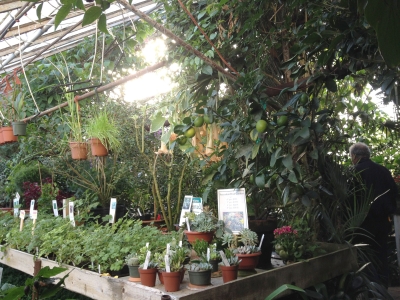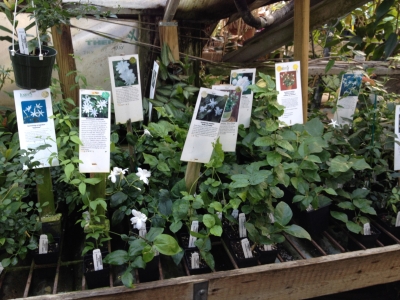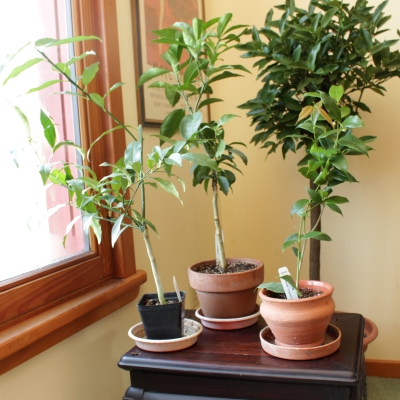OF FLOWERS AND TEMPERATURES
Flower, You Hoya
I probably shouldn’t admit this, but some plants suffer much neglect in my hands. My aloe, for example, has occasionally gone a whole year without a drop of water.
Hoya, also known as wax plant or Hindu rope plant, is another of my neglected plants. This plant is about 25 years old and has sat in the same pot in the same location for the past 15 years. The pot is only 3 inches square, dwarfed by the 3-foot-long “Hindu rope,” a single stem along which grow thick, green, involuted leaves. The hoya sits on a west-facing windowsill of a tower window in my house, and the lanky stem can drip down another 2 to 3 feet before it’s got to be shortened to keep from being bumped by anybody beneath it. One reason the plant gets watered so infrequently is because watering involves pulling out and climbing a ladder stairway to get to and gingerly water the relatively small pot.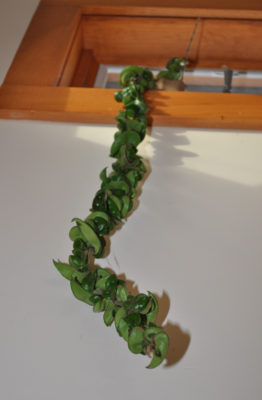
Another reason for the neglect is because hoya is a succulent whose thick fleshy leaves store water. The plant is more likely to die from too much water than too little.
Although I occasionally glance admiringly at the stem tracing down the wall, there are time periods when hoya grabs my attention. That’s when it flowers. The flowers arise in sprays of about a dozen, pinkish, tubular blossoms, each looking as if has been sculpted from wax. Not only are these flowers pretty, but they also emit the most delicious aroma of chocolate.
I’m not sure when or why my hoya flowers. Failure to bloom can be attributed to, according to reliable sources, “over-watering, over fertilization, insufficient sunlight, or plant immaturity. “ Ha! My guess is that a period of consistent, but not excessive, watering following the dry spells would coax the plant to flower. Now might be the time to start watering because, perhaps in celebration of lengthening days, the plant has, after all these years, sprouted a new shoot.
I’ll go and water the hoya right this minute.
And The Temperature Is . . . ?
“You never miss the water till the well runs dry,” goes the line from the old blues tune. In the same vein, you — or I, at least — never miss the thermometer till it breaks. I never realized how tied I was to the temperature until the number boxes on my digital thermometer started reading “- – – – -.”
Thermometers have come a long way since the liquid-in-glass ones that served so well for so many years mounted outside so many kitchen windows or on porch posts. You had to get close to read them, and they picked up some heat from proximity to the house.
After that came indoor-outdoor ones, using the same principal but with two glass columns. The “outdoor” column is fed by a thin tube threaded through a small hole in a window frame and ending with a sensing bulb. These thermometers let you essentially get your eyes further from the sensing portion.
Then came digital versions of both types of liquid-in-glass thermometers. Digital thermometers are just the ticket for those of us who like to know if the temperature is 31.4° F. or 32.2° F. Not that the sensors of these thermometers were necessarily accurate to 0.1° F (as stated, sometimes, in the fine print), but they did give a feeling of exactitude.
Still, all these thermometers measure temperatures in or near the house, unless you mounted one on a post out in the garden and kept running out to check the temperature. Or, you had a liquid-in-glass thermometer that registered the minimum and maximum temperatures since the last reading. As you might guess, I have one, have had it for over 30 years, in fact. Two sliding, iron indicators are pushed by the expanding fluid, with one indicator staying where it is pushed to its high point, the other to its low point. High and low temperatures are indicated for the period since the sliders were last reset by being slid back with a magnet against the fluid. Very elegant and very accurate, but you still have to run out to the garden to read the present temperature.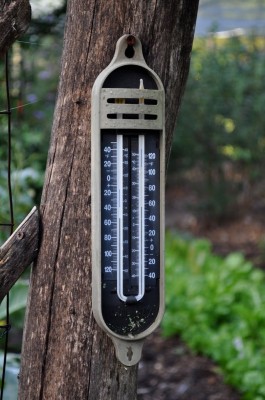
Enter wireless, digital, minimum-maximum thermometers, the ultimate in temperature readiness. With this thermometer (which, as you might have again guessed, I own), I can read present and extreme temperatures from the warmth of my bedroom. Except when they stop working. Then you really miss knowing the temperature to within a tenth of a degree.
Epilogue
Epilogue: Yes, I checked and changed the batteries. Customer support, last time I got through to them, tells me I have to use fresh batteries, not the rechargeable ones. And I have to take all the batteries out for 15 minutes. Then, while the outdoor and indoor sensors are 3 to 5 ft. apart, I have to first put in the outdoor sensor’s batteries, followed by the indoor sensor’s batteries, and let the sensors “communicate” for 20 minutes. Etc., etc. The thermometer still doesn’t work. Perhaps I should click my heals together three times. I bought a new, and, I hope, better one.

